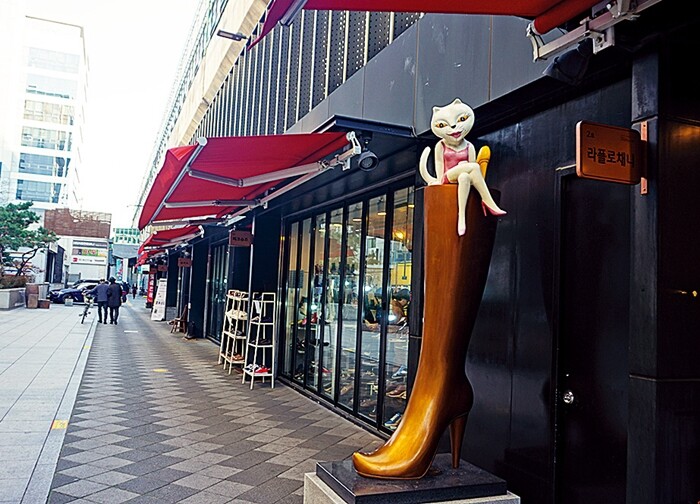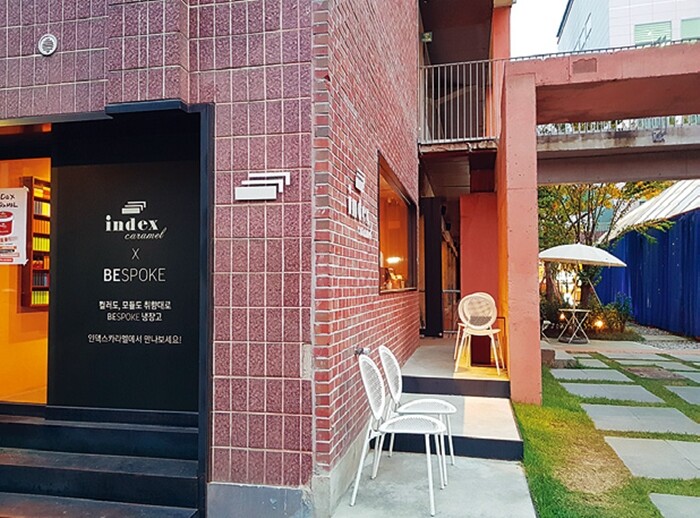hankyoreh
Links to other country sites 다른 나라 사이트 링크
[Seoul travels] Artisanal spirit brings life to new ideas

Some of the Koreans who visited the capital of the Qing Dynasty in the late 18th century were more interested in Beijing’s marketplaces and back alleys than in its flashy thoroughfares. I’m talking about Park Ji-won (pen name: Yeon-am) and Hong Dae-yong (pen name: Dam-heon).
Beijing’s winding alleyways, known as hutong, put everyday life on display, with shopkeepers selling vegetables and multicolored underwear fluttering on clotheslines. As Korean travelers took leisurely strolls through those alleyways, they were planting the seeds of Silhak, a paradigm shift from academic formalism to practical matters in the Joseon Dynasty. Just another example of the greatness of walking through back alleys.
In my previous essay, I left off at Ttukseom Station; today, I mean to explore the alleys around Seongsu Station, both on the Seoul subway system. When I get off the train at Seongsu Station, the pedestrian passageway on the second floor is occupied with an exhibition of dress shoes and handmade shoes.

While browsing through the exhibition material, I run into a question that catches me by surprise.
“Do you think the word ‘gudu’ [dress shoe] is a pure Korean word?” For my whole life, I’ve assumed the word is pure Korean, but it’s not.
When Korea opened up to foreign trade in the late 19th century, dress shoes were called “yanghwa,” literally meaning “Western shoes.” But when people who’d learned shoemaking techniques in Japan set up shops in Seoul, they called the shoes “kutsu,” using the Japanese word for “shoes.” Over time, the pronunciation changed to “gudu.”
Following the signs in the subway station, I head out of Exit 1 toward the handmade shoe district in Seongsu. But it turns out that Exit 2 may have been a better choice.
Several decorative items in the area — a cat perched atop knee-high boots, a big red stiletto, and a commemorative bronze plaque shaped like a foot — tell me I’ve reached the handmade shoe market.
I’m told that all these stores clustered together because they weren’t sure how else to market their wares.
According to statistics, Seongsu boasts 515 handmade shoe businesses in all. Finished women’s shoes account for 217 of them, compared with 29 making finished men’s shoes – making the percentage of women’s shoes nearly 10 times higher.

As you cross the street and head toward Exit 3 of Seongsu Station, the major street branching off to the side is Seongsui Road. Often called “Seongsu Cafe Street,” it’s the main thoroughfare in the neighborhood. It has a mixture of factories and galleries, craft stores and coffee houses. Examples of cutting-edge design peek out among the vintage red-brick buildings. The driving force behind the street’s renewal has been Daelim Warehouse. First built as a rice mill and later used as a distribution depot, it was acquired by a group of artists who renovated it into Daelim Changgo Gallery CO:LUMN in 2011. Jageumachi, a printing factory remodeled into a cafe, opened on the same street in 2014 — around the time people started calling Seongsu the “Brooklyn of Seoul.”
Next to Daelim Warehouse, a multipurpose space known as Baesan has been built with higher ceilings and a much larger scale. As I pass the bright murals and step inside the entrance, I’m greeted by half of a Mercedes. The central area with the high ceiling is used for exhibitions. A metal plate in the center was brought in from a scrapped ship. When the weather isn’t cold, it’s worth going up to the rooftop to enjoy a beer as you look out over the neighborhood. It’s a warehouse-style gallery cafe cum dining pub. The old factory exterior has been preserved, while the machinery and objects that were once used there accentuate the interior marvelously. This blend of modern and vintage has been described by Lonely Planet as the “most spectacular cafe in Asia.”
If Seongsui Road is the artery, then the nearby side streets are like capillaries. They’re used as workshops, studios and stores by painters, designers and photographers. Seongsu Yeonbang, which recently opened on Seongsu No. 14 Road behind Daelim Warehouse and Baesan, has drawn particular notice. Its name means “Seongsu Federation,” and it lives up to the name with its eclectic combination of craft beer pub, noodle restaurant, high-end tea shop, and boutique bookstore.
Leaving here and heading straight in the same direction from the intersection in front of Baesan, you find Yeonmujang Road. It’s often referred to as the “Materials Street,” as it’s where items are supplied to the nearby factories and shops along Seongsu’s shoemaking street. But this street too has been transformed quite a bit lately with coffee shops and bakeries. As the movie “Last Exit to Brooklyn” shows, the New York borough of Brooklyn was once a poor neighborhood on the margins. Since then, it’s transformed into a favored home for Manhattan’s well-to-do intellectuals and artists. Seongsu is no longer on the periphery either — it’s at the front lines of innovation. You can also see the side effects of gentrification unfolding here.
Daniel Day-Lewis and the artisanal spiritI find myself thinking of Daniel Day-Lewis, and how after becoming immensely popular through films like “A Room with a View,” “The Unbearable Lightness of Being,” and “My Left Foot,” he abruptly left Hollywood. It turns out that he went to apprentice in the mid-1990s at a humble shoe factory on the side streets of Florence. Amid the stench of leather, he sat in a shabby chair for eight hours a day cutting leather and threading soles. Accustomed to popular acclaim, he opted instead for the life of the artisan hermit. The place he chose was the factory of renowned footwear maker Stefano Bemer.
Day-Lewis faced persistent pressure to return to the screen, and after five years he did. He starred in Steven Spielberg’s “Lincoln,” and ended up taking home his third Oscar for Best Actor. Today, Bemer’s factory is popular among other aspiring apprentices. It’s located not in the part of Florence with all the tourist destinations, but across the Arno on a narrow alley in the San Niccolo neighborhood. From the outside, it seems quite humble, but it’s produced some of the finest footwear in the world, and one of the finest actors worked there. Beautiful Renaissance-era buildings aren’t the only thing Florence boasts. Its side streets are another important asset, where the artisanal spirit lives on.
You obviously need dazzling ideas and a hip sensibility — but equally important is the quiet spirit of the artisan. It’s not something that ever reveals itself to the world. Regeneration is an act of introducing new life into something that was fading away. Regenerating a neighborhood’s side streets isn’t something you can achieve with money and flash-in-the-pan ideas. You need more than just a beautiful Cinderella slipper – you also need to bring back the artisanal spirit.
By Son Kwan-seung, travel writer
Edited by Seoul&
Please direct comments or questions to [english@hani.co.kr]
Editorial・opinion
![[Guest essay] The real reason Korea’s new right wants to dub Rhee a founding father [Guest essay] The real reason Korea’s new right wants to dub Rhee a founding father](https://flexible.img.hani.co.kr/flexible/normal/500/300/imgdb/original/2024/0423/8317138574257878.jpg) [Guest essay] The real reason Korea’s new right wants to dub Rhee a founding father
[Guest essay] The real reason Korea’s new right wants to dub Rhee a founding father![[Column] ‘Choson’: Is it time we start referring to N. Korea in its own terms? [Column] ‘Choson’: Is it time we start referring to N. Korea in its own terms?](https://flexible.img.hani.co.kr/flexible/normal/500/300/imgdb/original/2024/0423/3617138579390322.jpg) [Column] ‘Choson’: Is it time we start referring to N. Korea in its own terms?
[Column] ‘Choson’: Is it time we start referring to N. Korea in its own terms?- [Editorial] Japan’s rewriting of history with Korea has gone too far
- [Column] The president’s questionable capacity for dialogue
- [Column] Are chaebol firms just pizza pies for families to divvy up as they please?
- [Column] Has Korea, too, crossed the Rubicon on China?
- [Correspondent’s column] In Japan’s alliance with US, echoes of its past alliances with UK
- [Editorial] Does Yoon think the Korean public is wrong?
- [Editorial] As it bolsters its alliance with US, Japan must be accountable for past
- [Guest essay] Amending the Constitution is Yoon’s key to leaving office in public’s good graces
Most viewed articles
- 1[Column] ‘Choson’: Is it time we start referring to N. Korea in its own terms?
- 2Why Korea shouldn’t welcome Japan’s newly beefed up defense cooperation with US
- 3Senior doctors cut hours, prepare to resign as government refuses to scrap medical reform plan
- 4[Guest essay] The real reason Korea’s new right wants to dub Rhee a founding father
- 5Samsung barricades office as unionized workers strike for better conditions
- 6Opposition calls Yoon’s chief of staff appointment a ‘slap in the face’
- 7[Column] The clock is ticking for Korea’s first lady
- 8[Editorial] Japan’s rewriting of history with Korea has gone too far
- 9New AI-based translation tools make their way into everyday life in Korea
- 10Terry Anderson, AP reporter who informed world of massacre in Gwangju, dies at 76